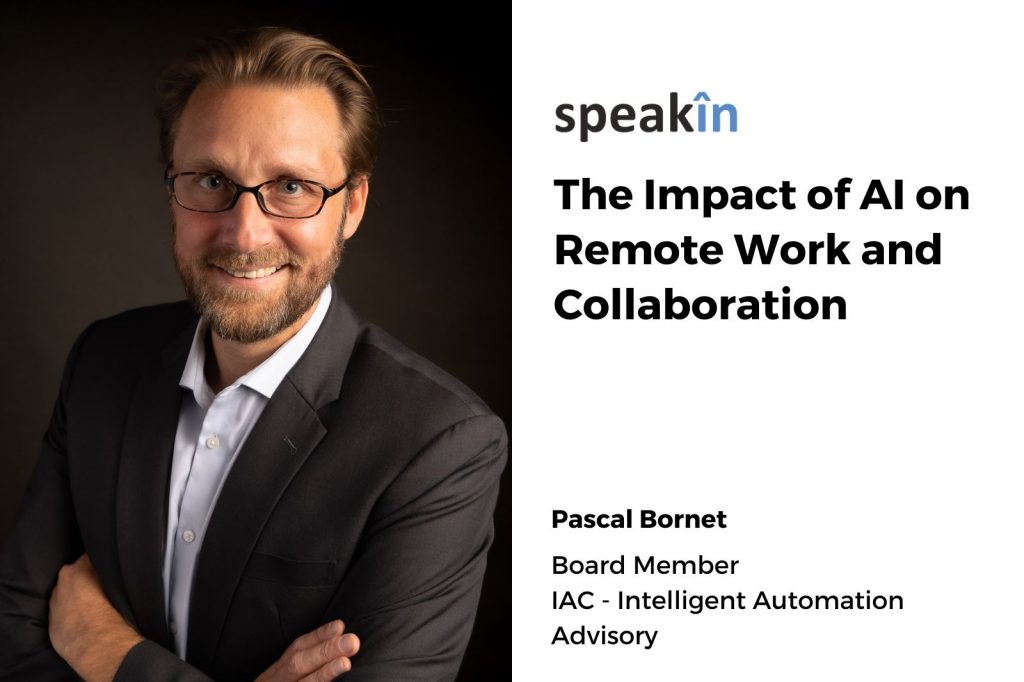The Impact of AI on Remote Work and Collaboration

Rapidly advancing technology is revolutionizing the world as we know it. With each passing day, new and groundbreaking innovations are reshaping the workplace. From cutting-edge generative AI co-pilot coding platforms to the remarkable capabilities of digital twins, industrial cobots, and the transformative power of edge computing, the possibilities seem endless. As these transformative technological forces reshape the landscape, businesses and their workforce are left wondering what it means for them and how they might keep human connection, collaboration, and creativity at the center of everything they do.
1. Integrating AI into a remote or hybrid workplace
In the face of relentless digital progress, businesses are compelled to embrace global talent and synchronize teams scattered across the globe. This paradigm shift has propelled remote and hybrid work from fleeting trends or employee perks to indispensable requisites. However, navigating the intricacies of hybrid and remote working presents formidable challenges. The demands of multinational markets necessitate businesses to engage internationally distributed, culturally diverse, and multilingual workforces. This presents a daunting task of communication, coordination, and collaboration on a truly global scale. To thrive in this dynamic landscape and unlock the full potential of remote and hybrid work, workplaces are increasingly turning to the remarkable power of AI-driven collaboration platforms such as Zoom.
By harnessing the cutting-edge capabilities of artificial intelligence, businesses can take knowledge sharing to new heights, improving workplace productivity, powering collaboration with teammates, and enhancing how remote or hybrid workers connect with customers. For example, businesses are using AI to analyze meeting recordings, thereby unlocking invaluable insights and summarizing key actions. By analyzing historical conversational data, AI algorithms can uncover patterns, enabling businesses to make informed predictions about future trends, anticipate challenges, or identify untapped business opportunities. Sales leaders can gain meaningful and actionable insights into customer interactions, identifying service gaps that require additional staff training and seizing potential up-sell or cross-sell opportunities that may have been previously overlooked.
Smart, always-on, multi-channel conversational AI and chatbot solutions can now utilize machine learning service agents to provide more accurate and efficient customer service responses, ultimately leading to faster first-contact resolution. Delivering consistent, rich, personalized answers on every service call enhances customer and employee satisfaction (CSAT), which helps drive Net Promoter Scores (NPS) and ultimately results in higher sales and customer retention.
Real-time translation uses machine learning and natural language processing to provide live translation and transcriptions of multi-lingual meetings to provide real-time insights and analytics that can help businesses make more data-driven decisions. For example, AI-powered analytics tools can analyze meeting data and provide insights into how to optimize team productivity. Live translation and transcriptions of meetings can help foster far greater understanding, engagement, and trust between customers and colleagues around the world. As a result, remote and hybrid workers gain access to international markets and seize new business opportunities by delivering sales pitches in multiple languages in an impactful way that helps drive influence and ROI.
2. Navigating a world of possibilities
AI is opening up a world of possibilities for businesses seeking to unlock the full creative potential of their globally dispersed remote or hybrid workforces. This offers notable advantages such as increased flexibility, better work-life balance, reduced commuting, and access to a wider talent pool. However, it also exposes employees to risks such as work-life boundary issues, social isolation, and communication barriers. Thankfully, businesses have swiftly grasped the transformative potential of AI-infused communication and collaboration platforms to tackle these hurdles head-on. For instance, business leaders can leverage their collaboration platforms for virtual gatherings, team lunches, or quizzes to regularly connect with employees.
This helps to bolster employee engagement, nurtures a thriving virtual work culture, and swiftly addresses any pressing work-related obstacles. Virtual whiteboards, for example, can empower teams to collectively brainstorm ideas and drive innovation, helping workers transcend the limitations of physical proximity to communicate and collaborate better. By harnessing the power of AI-enabled communication and collaboration solutions, businesses can help workers combat feelings of isolation or loneliness sometimes associated with remote or hybrid work arrangements and foster innovative thinking amongst their global workforce.
3. Unlocking a world of AI-infused collaborative possibilities
The future of work is rapidly evolving, driven by the transformative power of artificial intelligence (AI). With AI at the helm, workers can expect a paradigm shift in their everyday experiences, unlocking new possibilities for how they communicate, collaborate and work. While concerns around AI, such as bias or inconsistent answers, are understandable, there are strategies to overcome these challenges. By acknowledging and addressing biases, leveraging diverse and authoritative data sources, and maintaining a critical eye when analyzing data patterns and AI responses, we can mitigate or even avoid these pitfalls.
The benefits of AI far outweigh the potential harm. As work becomes increasingly digital, AI and machine learning will play increasingly pivotal roles in our daily working lives. AI-infused collaborative platforms such as Zoom introduce capabilities that enhance human-to-human interactions. They foster stronger communication among colleagues, teams, and customers, ultimately making each conversation more meaningful and productive.
Nowadays, customers expect quick, intelligent answers that address their queries in a meaningful, personalized, and frictionless manner. Businesses that invest in AI-powered communication and collaboration platforms can gain a competitive edge by capturing the hearts and minds of employees and customers alike by making communicating together easier and richer. As such, AI-powered collaboration platforms optimized for video engagement will grow in popularity as customers increasingly demand to see and speak with agents, regardless of device, location, language, or time of day.
As AI technology continues to advance, businesses can expect to see even more sophisticated AI-powered tools that will enhance the hybrid and remote work experience even further. For example, AI-powered virtual assistants will be able to anticipate employees' needs and provide personalized recommendations to enhance productivity. These tools will also be able to provide real-time insights into team dynamics, allowing managers to optimize their teams’ performance.
Those businesses that harness the power of AI to create exceptional employee experiences will reap the rewards of a happier and more engaged workforce, improved operational efficiency, greater employee retention rates, and enhanced customer service. Each of which will contribute to elevated sales, renewals, and return on investment. However, it is crucial to remember that the purchase of an AI-infused communication and collaboration platform is merely the first step in its successful implementation. It is important that the technology aligns with the company’s overall strategic objectives and goals. Therefore, thorough research, planning, and evaluation are necessary to understand the potential impact on existing processes, workflows, and workforce.
Change management strategies should then be in place to ensure a smooth implementation and minimize disruption to the company's operations. Providing comprehensive training and support for employees to adapt to the new collaborative technology is vital for its successful implementation. Regular monitoring and evaluation of the collaborative AI technologies’ performance are also essential to identify areas for improvement and ensure its continued effectiveness as business needs evolve. These proactive measures empower businesses to address challenges and pitfalls, ensuring that collaborative AI technology remains a valuable asset and an effective business tool.
4. Three key skills to build for the digital age
As the influence of AI permeates every aspect of our professional lives, job roles will inevitably change. To flourish, employees will need to develop three essential skills: critical thinking, relationship building, and creativity. Critical thinking empowers individuals to analyze complex problems, think independently, and make informed decisions amidst multifaceted and unpredictable workplace challenges. By questioning, scrutinizing, and seeking comprehensive insights, we can ensure the reliability, completeness, and credibility of AI-driven outputs. Thought-provoking questions, active listening, objective analysis, and consideration of alternative solutions are essential components of this cognitive skill set.
While computers may never be able to truly comprehend human thoughts and emotions, the ability to build relationships is an increasingly valuable asset. Building and maintaining strong professional relationships fosters teamwork, effective communication, and the exchange of ideas. Leveraging these relationships across diverse teams unlocks collective intelligence, propelling innovation, building trust, and enabling businesses to achieve their objectives.
Creativity, the act of crafting novel components, distinguishes us from artificial intelligence. It’s what we do with our minds, but it also involves our personalities, our background, and the specific traits that make us unique. In an increasingly automated world, creativity becomes a key differentiator. It involves thinking outside the box, generating fresh ideas, and discovering innovative approaches to problem-solving. Creative individuals infuse businesses with new perspectives and help drive innovation forward. They embrace brainstorming and curiosity, and engage in creative pursuits, venturing into unconventional territories and reflecting on setbacks as part of their growth process. They use technology to augment their ideas, embrace experimentation, explore unconventional solutions, self-reflect to learn from setbacks, and view failure as part of the creative process. This helps businesses adapt, evolve, and stay competitive in a technology-driven age.
By honing critical thinking, relationship building, and creative skills, individuals can not only adapt to the AI era but also seize upon the collaborative potential of humans and machines to thrive in this transformative hybrid age.
5. Empowering human connection with AI-infused collaboration technology
The accelerated adoption of remote and hybrid work models within businesses has demonstrated their resiliency and adaptability in transforming the way they work. The widespread implementation of remote and hybrid work has resulted in enhanced employee, customer, and business outcomes, reaffirming the enduring significance of human connection in the modern workplace. As such, remote and hybrid work has become indispensable for businesses aiming to attract and retain top talent, optimize operational efficiency, and remain competitive in an ever-evolving digital world.
However, these work models also present challenges, including work-life boundary issues, social isolation, and communication barriers. To overcome these challenges, businesses have embraced AI-powered platforms to empower workers to connect and collaborate. By embracing AI as a powerful enabler, businesses are unlocking the full potential of their distributed workforce by ensuring people remain at the heart of their operations. AI collaboration platforms such as Zoom now play a crucial role in preserving this essential aspect of human interaction and helping make the world a more humane place for everyone.
ABOUT THE AUTHOR
Pascal Bornet is one of LinkedIn Top Voice in Tech '19, sought-after keynote speaker, best-selling author, AI & Automation expert. Bornet is also a senior executive with 20+ years of experience in digital transformations. He founded and led the “AI & Automation” practices at McKinsey and at Ernst & Young (EY). He is currently on the leadership team of Aera Technology, an innovative startup. He is passionate about making our world more human with Artificial Intelligence, Automation, and Technology in general. He was awarded Global Top Voice in Tech in 2019 with 400k+ followers on LinkedIn, Twitter, and other social media.





